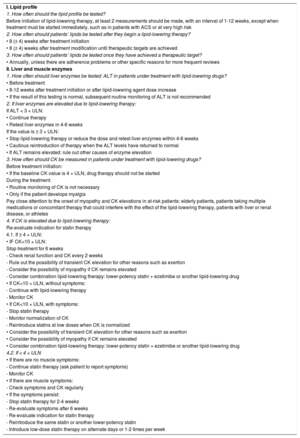In the article entitled, “Comments on the 2016 ESC/EAS Guidelines for the Management of Dyslipidemias” (Rev Esp Cardiol. 2017;70:72-77), errors have been detected in Table 2.
Recommendations for the Systematic Analysis of Lipids and Enzymes
| I. Lipid profile |
| 1. How often should the lipid profile be tested? |
| Before initiation of lipid-lowering therapy, at least 2 measurements should be made, with an interval of 1-12 weeks, except when treatment must be started immediately, such as in patients with ACS or at very high risk |
| 2. How often should patients’ lipids be tested after they begin a lipid-lowering therapy? |
| • 8 (± 4) weeks after treatment initiation |
| • 8 (± 4) weeks after treatment modification until therapeutic targets are achieved |
| 3. How often should patients’ lipids be tested once they have achieved a therapeutic target? |
| • Annually, unless there are adherence problems or other specific reasons for more frequent reviews |
| II. Liver and muscle enzymes |
| 1. How often should liver enzymes be tested: ALT in patients under treatment with lipid-lowering drugs? |
| • Before treatment |
| • 8-12 weeks after treatment initiation or after lipid-lowering agent dose increase |
| • If the result of this testing is normal, subsequent routine monitoring of ALT is not recommended |
| 2. If liver enzymes are elevated due to lipid-lowering therapy: |
| If ALT < 3 × ULN: |
| • Continue therapy |
| • Retest liver enzymes in 4-6 weeks |
| If the value is ≥ 3 × ULN: |
| • Stop lipid-lowering therapy or reduce the dose and retest liver enzymes within 4-6 weeks |
| • Cautious reintroduction of therapy when the ALT levels have returned to normal |
| • If ALT remains elevated: rule out other causes of enzyme elevation |
| 3. How often should CK be measured in patients under treatment with lipid-lowering drugs? |
| Before treatment initiation: |
| • If the baseline CK value is 4 × ULN, drug therapy should not be started |
| During the treatment: |
| • Routine monitoring of CK is not necessary |
| • Only if the patient develops myalgia |
| Pay close attention to the onset of myopathy and CK elevations in at-risk patients: elderly patients, patients taking multiple medications or concomitant therapy that could interfere with the effect of the lipid-lowering therapy, patients with liver or renal disease, or athletes |
| 4. If CK is elevated due to lipid-lowering therapy: |
| Re-evaluate indication for statin therapy |
| 4.1. If ≥ 4 × ULN: |
| • IF CK<10 × ULN: |
| Stop treatment for 6 weeks |
| - Check renal function and CK every 2 weeks |
| - Rule out the possibility of transient CK elevation for other reasons such as exertion |
| - Consider the possibility of myopathy if CK remains elevated |
| - Consider combination lipid-lowering therapy: lower-potency statin + ezetimibe or another lipid-lowering drug |
| • If CK<10 × ULN, without symptoms: |
| - Continue with lipid-lowering therapy |
| - Monitor CK |
| • If CK<10 × ULN, with symptoms: |
| - Stop statin therapy |
| - Monitor normalization of CK |
| - Reintroduce statins at low doses when CK is normalized |
| • Consider the possibility of transient CK elevation for other reasons such as exertion |
| • Consider the possibility of myopathy if CK remains elevated |
| • Consider combination lipid-lowering therapy: lower-potency statin + ezetimibe or another lipid-lowering drug |
| 4.2. If < 4 × ULN |
| • If there are no muscle symptoms: |
| - Continue statin therapy (ask patient to report symptoms) |
| - Monitor CK |
| • If there are muscle symptoms: |
| - Check symptoms and CK regularly |
| • If the symptoms persist: |
| - Stop statin therapy for 2-4 weeks |
| - Re-evaluate symptoms after 6 weeks |
| - Re-evaluate indication for statin therapy |
| - Reintroduce the same statin or another lower-potency statin |
| - Introduce low-dose statin therapy on alternate days or 1-2 times per week |
ACS, acute coronary syndrome; ALT, alanine aminotransferase; CK, creatine kinase; ULN, upper limit of normal.
In point II.2, the text incorrectly states on 2 occasions, “retest liver enzymes in 46 weeks”, when it should say, “retest liver enzymes in 4-6 weeks”.
In point II.4.2, in the last line, where the text says, “on alternate days or 12 times per week”, it should say, “on alternate days or 1-2 times per week”.
These corrections were introduced in the electronic version of the article on 4th April, 2018. The correct table is:

